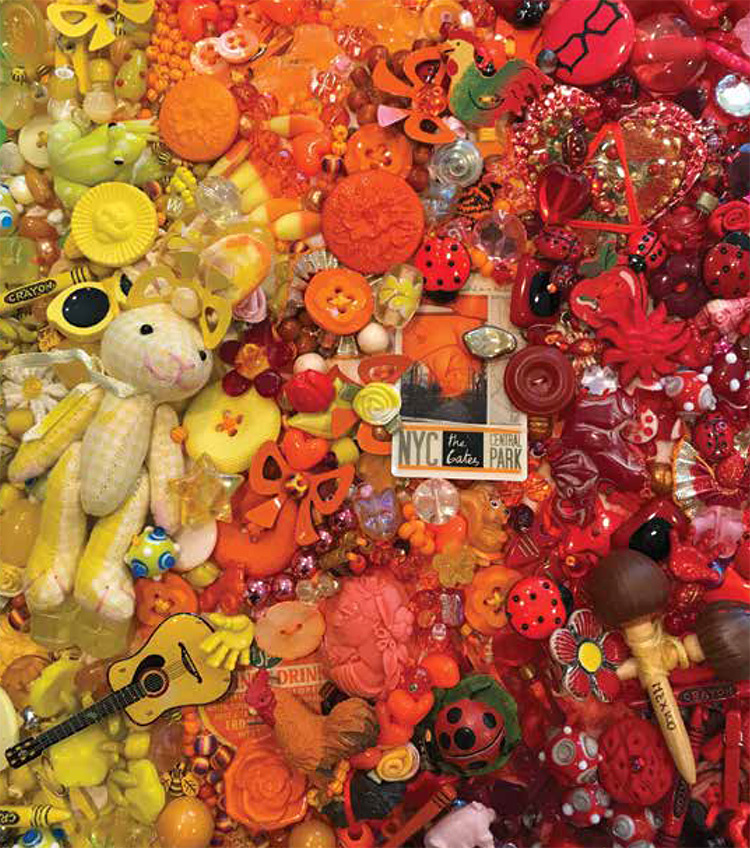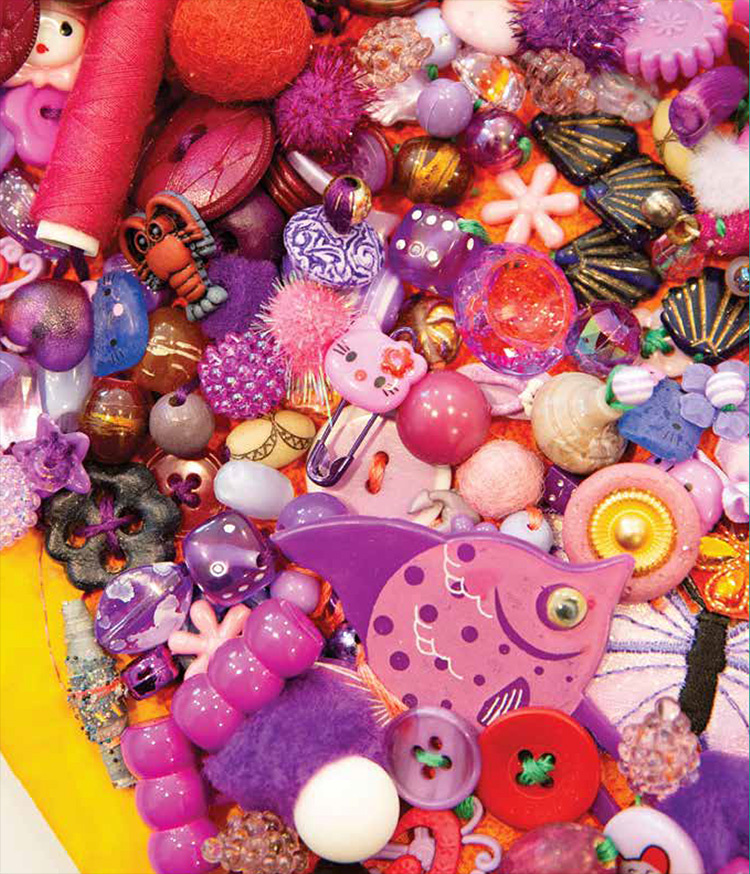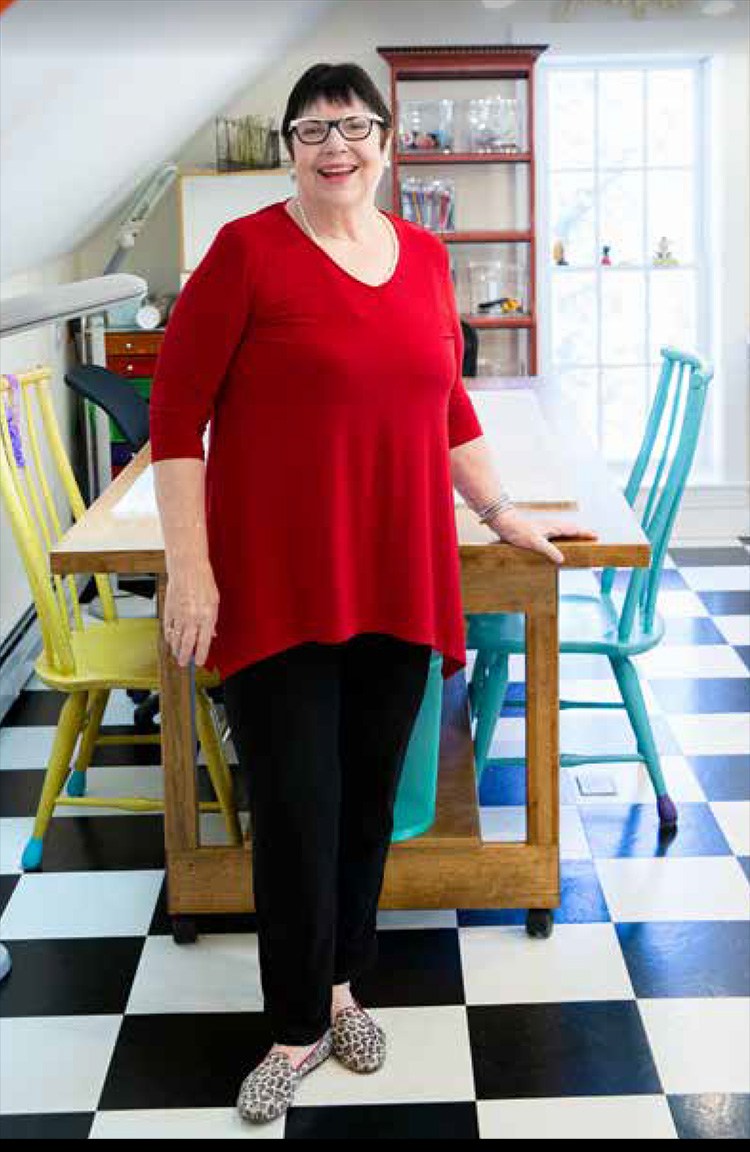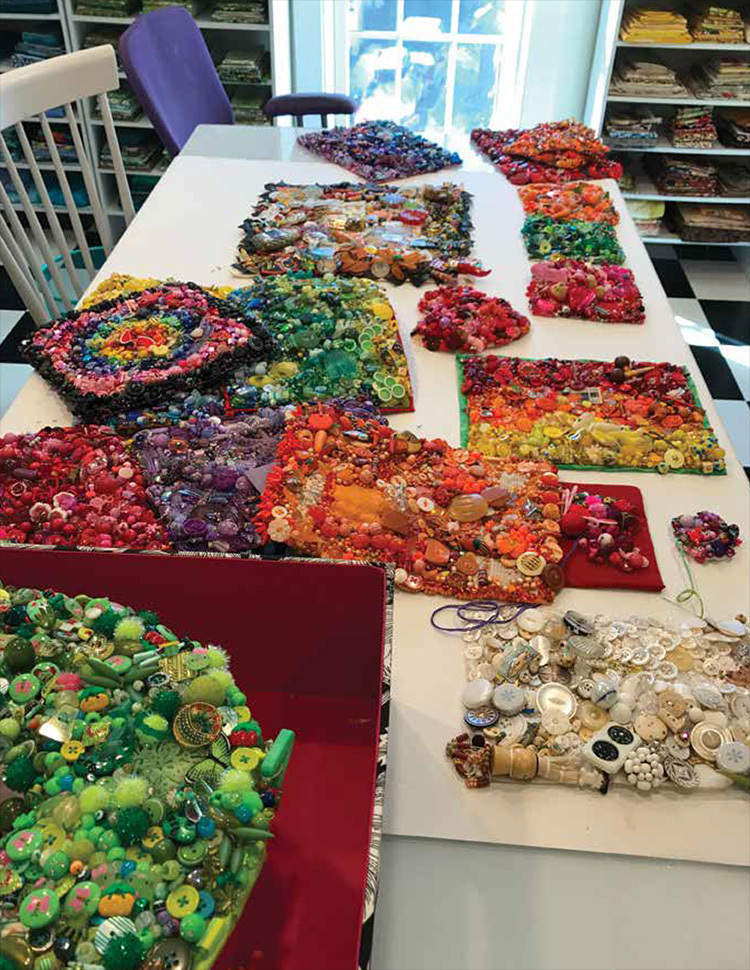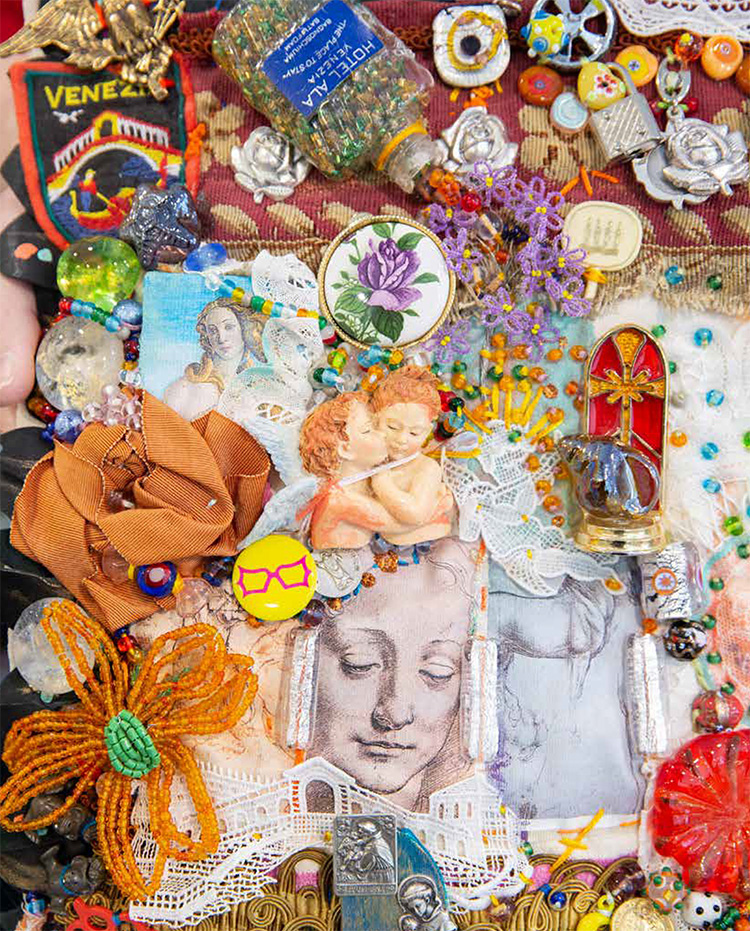Collectors and artists are sometimes interchangeable. It is a matter of perspective. I am not going to be visited by the television show hoarding interventionists, but there are some days when I wonder. If the color is unusual, or if the color is just color, I want that too. If it is an unusual shape and I can get it into my purse, watch out. No, I don’t collect fishing worms, as a child might, but by the end of my day, there may be drink caps, beads, shells, a feather or something unidentifiable in my stash. My studio is lined with clear boxes with carefully color sorted items. This could be misleading since it seems so well organized. My dark little secret is that there is a basement full of collected items, along with collected fabric. I admit that my guest room drawers are full. No storage shed. No, No, No.
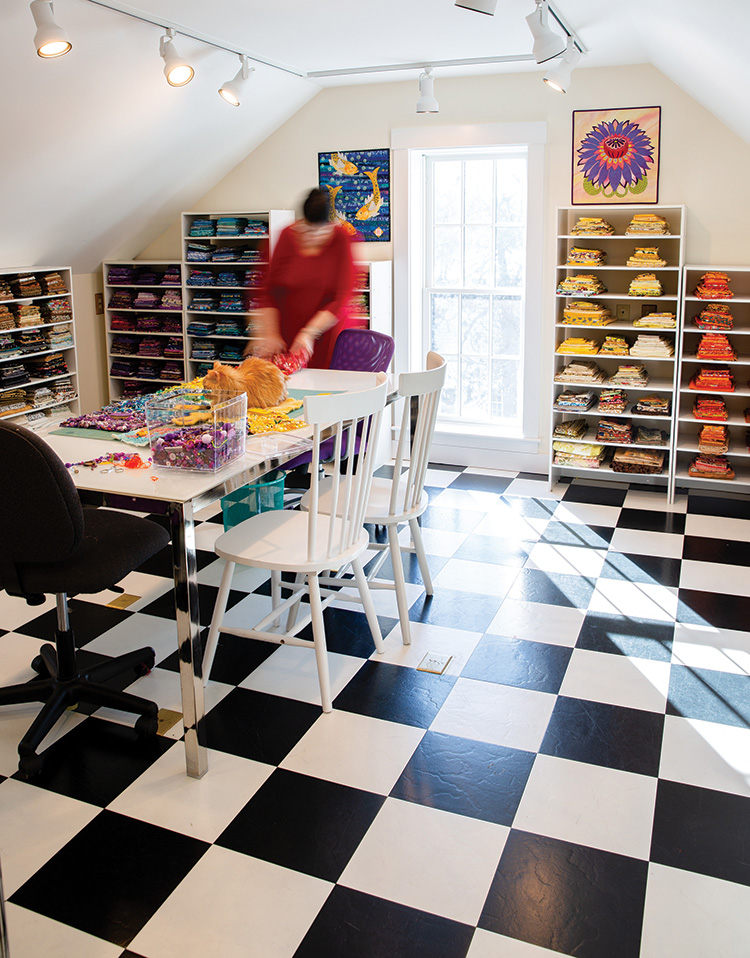
I am fascinated with the artist El Anutusi, who works only with discarded liquor bottle caps. Gaudi’s architectural work draws me in with his use of broken shards and ceramics. Jane Perkins has become well known with her found object portraits and iconic images. Simon Rodia’s Watts Towers in Los Angeles felt like home to me with all the collected items so energetically placed in walls, floors and towering spires.
I am like the proverbial small child with a pocket full of treasures.
I grew up in Bellaire, Texas, a small incorporated city now surrounded by Houston, and I now live in Grafton, Vermont. Growing up we were encouraged in our creativity and I spent a good part of my free time foraging for “things to make things with.” Nothing was too small or too mundane. I collected seeds, shells, pebbles, and anything else that I could pick up.
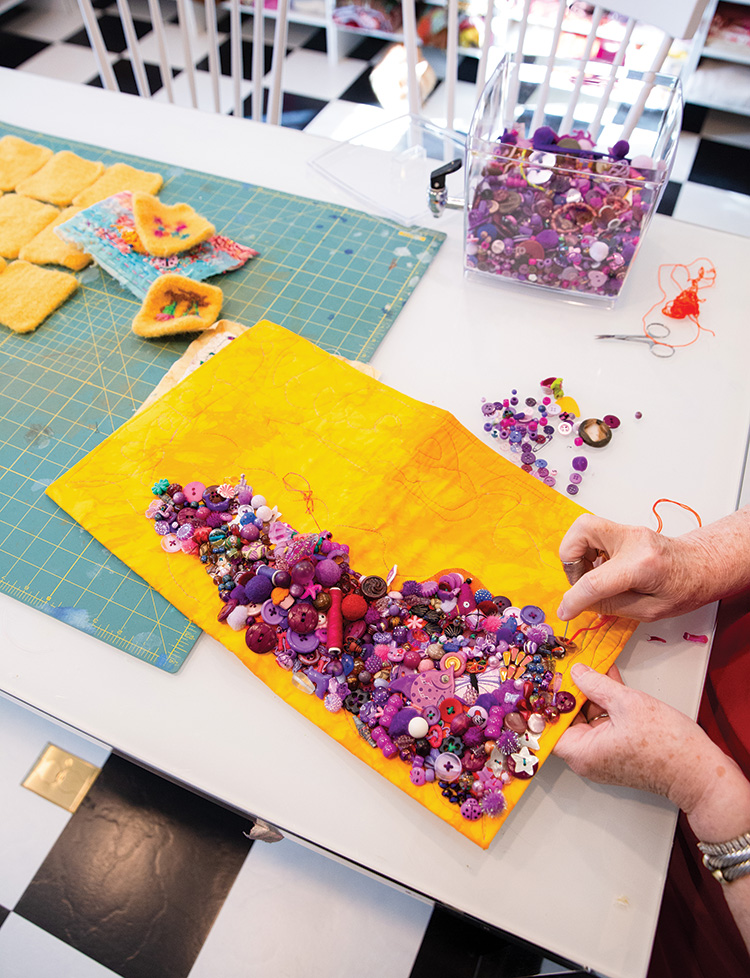
We had a set of the Book of Knowledge, published in the early 1940s. There were articles and black and white pictures on all kinds of subjects. There were also projects that could be done. Later, the Jack and Jill magazine came regularly to our house with all kinds of ideas about what could be done and what could be made.
My parents were not perfectionists; they let us explore our ideas. I was the oldest child. I think my mother was clever enough to encourage me to learn to cook. It served a great purpose once I was able to make the whole meal. That would have been by the time I was twelve. As for art, if we could assemble the materials it was a “go for it.” I learned to sew with the sewing machine by age thirteen and made my own clothes soon after.
In my past, imagining what I could work on or make next was a great stress relief. I started creating as young as I was able to manipulate objects. As an adult, I think that creating takes the largest part of my brain space. I have to eat, bathe, groom, dress and do a little housework, but the background music playing in my head is to create something.
When I was younger, I had no idea that other people did not feel the way I did. Sometime in first grade, the other kids suggested that I should be the one to make or draw something when there was a special project. It dawned on me because other people mentioned it. I learned to sew when I was six and could handle a needle and thread. I also learned to knit that year. I learned how to string beads around that time, and I was born knowing how to draw. Being able to sew colorful found objects onto a fiber substrate is a natural progression of this.
I collect beads, buttons and small toys, along with things that are usually thrown away, such as bottle caps or pop tops. If it has a hole or a way to sew it down and it will not disintegrate, I will use it. I collect all these items in clear acrylic containers, sorted by color.
How do I find these objects? And where? Everywhere! I am always looking at thrift shops, yard sales and flea markets. Old jewelry is a great source of beads. Small items from board games are good too. When some of the craft stores are having sales on buttons and beads, it is a good time to add to the stash. I do try to be careful not to overspend on new inventory. I have also found interesting things in hardware stores.
Every child is an artist.
The problem is how to remain an artist once we grow up.
—Pablo Picasso
To make a piece, I use a very heavy material as a substrate. This can be a heavy duty Pellon or several layers of felt. Each item is sewed on individually. The thread used is either a Silomide thread which is very strong and used in tailoring, or I use six-strand embroidery floss, using all the strands. Some of my work has been to make monochromatic pieces, using many different objects of the same color. Others are forms with the colors used in smaller areas to depict an item. Color merges are also fun to do. When selecting thread, I often use the color opposite of the piece being sewn down (green on red, orange on blue) as this gives a little spark to the entire piece.
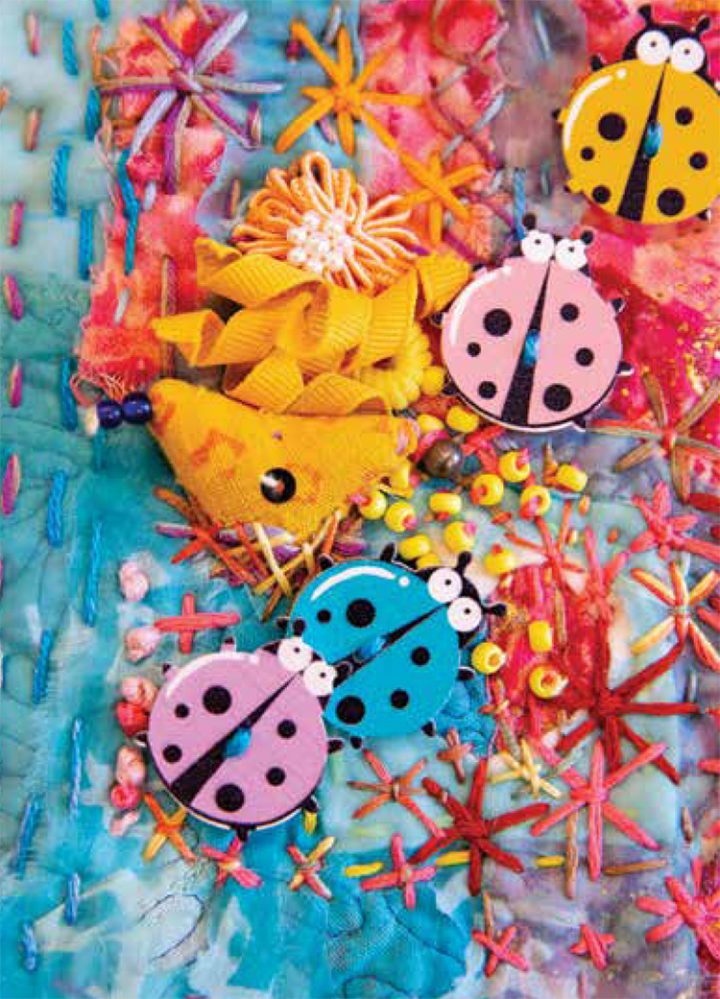
My process begins with using a strong support fabric background such as felt or Pellon, then covering it with quilting cotton in the color of my choice. If there is a pattern, I draw it onto the fabric. Then I sew beads, buttons, etc. on one at a time and very closely together—I like to let them overlap or stack. Then I fill all the areas of design, bind and complete. Lastly, I add a sleeve and label.
If it sparkles, I want it.
I think about a project or a subject and rehearse it in my mind. Eventually I have to stand up and go do it. I am very spontaneous, very colorful. I have a great passion for repurposing and using found objects as well as buttons, beads and small toys. I find ideas and inspiration everywhere. I find it from the objects I see. Travel gives great ideas; I have definitely been inspired by so much travel. Other artists’ work is a great source of stimulation as well.
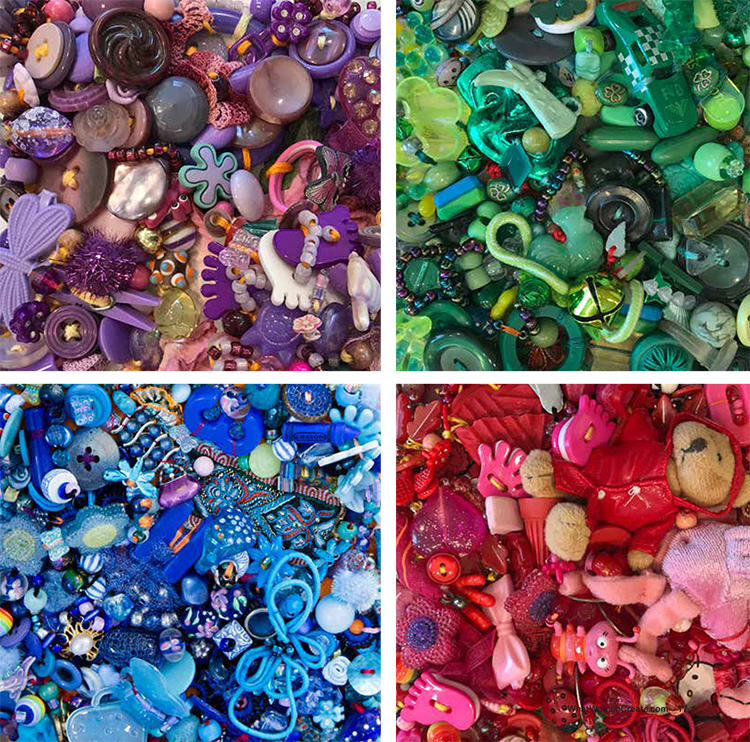
The challenge for all of us is carving out enough time. The other, for me, is keeping the workspace organized and tidy enough to work. Over time I have learned to finish things in time for deadlines and have had my work displayed and published. I’m very proud that my art has been so well-received!
Collectors and artists are sometimes interchangeable. It is a matter of perspective. I am not going to be visited by the television show hoarding interventionists, but there are some days when I wonder. If the color is unusual, or if the color is just color, I want that too. If it is an unusual shape and I can get it into my purse, watch out. No, I don’t collect fishing worms, as a child might, but by the end of my day, there may be drink caps, beads, shells, a feather or something unidentifiable in my stash. My studio is lined with clear boxes with carefully color sorted items. This could be misleading since it seems so well organized. My dark little secret is that there is a basement full of collected items, along with collected fabric. I admit that my guest room drawers are full. No storage shed. No, No, No.

I am fascinated with the artist El Anutusi, who works only with discarded liquor bottle caps. Gaudi’s architectural work draws me in with his use of broken shards and ceramics. Jane Perkins has become well known with her found object portraits and iconic images. Simon Rodia’s Watts Towers in Los Angeles felt like home to me with all the collected items so energetically placed in walls, floors and towering spires.
I am like the proverbial small child with a pocket full of treasures.
I grew up in Bellaire, Texas, a small incorporated city now surrounded by Houston, and I now live in Grafton, Vermont. Growing up we were encouraged in our creativity and I spent a good part of my free time foraging for “things to make things with.” Nothing was too small or too mundane. I collected seeds, shells, pebbles, and anything else that I could pick up.

We had a set of the Book of Knowledge, published in the early 1940s. There were articles and black and white pictures on all kinds of subjects. There were also projects that could be done. Later, the Jack and Jill magazine came regularly to our house with all kinds of ideas about what could be done and what could be made.
My parents were not perfectionists; they let us explore our ideas. I was the oldest child. I think my mother was clever enough to encourage me to learn to cook. It served a great purpose once I was able to make the whole meal. That would have been by the time I was twelve. As for art, if we could assemble the materials it was a “go for it.” I learned to sew with the sewing machine by age thirteen and made my own clothes soon after.
In my past, imagining what I could work on or make next was a great stress relief. I started creating as young as I was able to manipulate objects. As an adult, I think that creating takes the largest part of my brain space. I have to eat, bathe, groom, dress and do a little housework, but the background music playing in my head is to create something.
When I was younger, I had no idea that other people did not feel the way I did. Sometime in first grade, the other kids suggested that I should be the one to make or draw something when there was a special project. It dawned on me because other people mentioned it. I learned to sew when I was six and could handle a needle and thread. I also learned to knit that year. I learned how to string beads around that time, and I was born knowing how to draw. Being able to sew colorful found objects onto a fiber substrate is a natural progression of this.
I collect beads, buttons and small toys, along with things that are usually thrown away, such as bottle caps or pop tops. If it has a hole or a way to sew it down and it will not disintegrate, I will use it. I collect all these items in clear acrylic containers, sorted by color.
How do I find these objects? And where? Everywhere! I am always looking at thrift shops, yard sales and flea markets. Old jewelry is a great source of beads. Small items from board games are good too. When some of the craft stores are having sales on buttons and beads, it is a good time to add to the stash. I do try to be careful not to overspend on new inventory. I have also found interesting things in hardware stores.
Every child is an artist.
The problem is how to remain an artist once we grow up.
—Pablo Picasso
To make a piece, I use a very heavy material as a substrate. This can be a heavy duty Pellon or several layers of felt. Each item is sewed on individually. The thread used is either a Silomide thread which is very strong and used in tailoring, or I use six-strand embroidery floss, using all the strands. Some of my work has been to make monochromatic pieces, using many different objects of the same color. Others are forms with the colors used in smaller areas to depict an item. Color merges are also fun to do. When selecting thread, I often use the color opposite of the piece being sewn down (green on red, orange on blue) as this gives a little spark to the entire piece.

My process begins with using a strong support fabric background such as felt or Pellon, then covering it with quilting cotton in the color of my choice. If there is a pattern, I draw it onto the fabric. Then I sew beads, buttons, etc. on one at a time and very closely together—I like to let them overlap or stack. Then I fill all the areas of design, bind and complete. Lastly, I add a sleeve and label.
If it sparkles, I want it.
I think about a project or a subject and rehearse it in my mind. Eventually I have to stand up and go do it. I am very spontaneous, very colorful. I have a great passion for repurposing and using found objects as well as buttons, beads and small toys. I find ideas and inspiration everywhere. I find it from the objects I see. Travel gives great ideas; I have definitely been inspired by so much travel. Other artists’ work is a great source of stimulation as well.

The challenge for all of us is carving out enough time. The other, for me, is keeping the workspace organized and tidy enough to work. Over time I have learned to finish things in time for deadlines and have had my work displayed and published. I’m very proud that my art has been so well-received!





